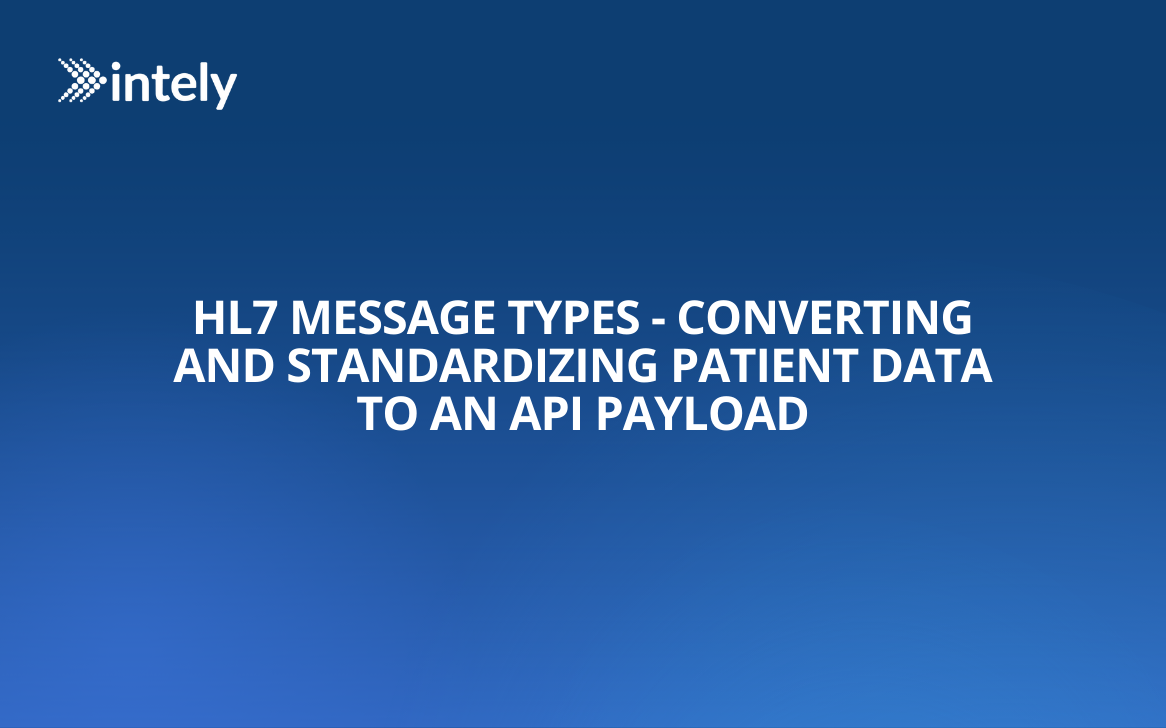What’s New with intely: May Roundup
Here are the highlights of all the content we have posted in the past month. We hope this will give you a sense of what intely is all about, and you'll feel…
HL7 Message Types & Structure HL7 version 2 is a messaging protocol that allows different software applications in healthcare to communicate with one…
.png)

HL7 Message Types & Structure
HL7 version 2 is a messaging protocol that allows different software applications in healthcare to communicate with one another. The HL7 message type defines the high-level purpose and grouping of the message. Here are some commonly used HL7 message types:
ACK – General acknowledgment
ADT – Admit, Discharge, Transfer
BAR – Add/change billing account
DFT – Detailed financial transaction
MDM – Medical document management
MFN – Master files notification
ORM – Order (Pharmacy/treatment)
ORU – Observation result (unsolicited)
QRY – Query, original mode
RAS – Pharmacy/treatment administration
RDE – Pharmacy/treatment encoded order
RGV – Pharmacy/treatment give
SIU – Scheduling information unsolicited
VXU – Unsolicited vaccination record update
HL7 defines quite a few message types. You can check out the complete list here. Comparisons can be made between HL7 message types and HL7 FHIR resource categories.
HL7 message types are combined with a trigger event, which initiates writing and sending the message. The message type and trigger event format is: {messageType_triggerEvent}. This data will be present in every HL7 message in MSH-9 (the MSH segment, field position 9).
HL7 messages are constructed with a predefined sequence of required and optional message segments. Message segments also have defined fields that are required and optional and appear in a specified order.
HL7 PID Segment
The PID (patient identification information) segment is present in most HL7 message types and contains permanent identifying and demographic information that, for the most part, will not frequently change. The segment is critical and the primary means of communicating patient identification information.
MSH|^~\&|INTELY|INTELY|CONNECT||20210527135249||ADT^A05|Q292942960T328585861|P|2.3||||||8859/1
EVN
PID|1|8675309^^^MRN^MRN|8338178675309^^^MRN^MRN||PatientLname^PatientFname^^^^^Current||20000101|F|||123^^Health Level Seven Ln^FL^33578^USA^home^^Tampa|||(999)999-9999^Business^TEL|English|||19098765439^^^FIN^FIN|||||||0
PV1|1|P|CLINIC^^^HS1^^Ambulatory(s)^CLINIC|EL|||1099999999^Ross^Bob^B^^MD|||COV||||1|||1099999999^Ross^Bob^B^^MD|PR||HM|||||||||||||||||||HS1||FL
Many healthcare software providers require utilizing HL7 v2 to integrate and automate data workflows fully. The task of setting up these integrations is no minor feat. It requires engineers with a specialized skillset and often more troubleshooting than anticipated. Check out the benefits of partnering with an interoperability platform with out-of-the-box HL7 interfaces.
FHIR Resources
HL7 FHIR (Fast Healthcare Interoperability Resources) is a newer interoperability standard based on REST, which describes how individual transactional units (FHIR Resources) can be easily shared between systems. You may have already discovered that Intely can convert HL7 v2 to FHIR with sophisticated mapping and transformation.
Here are some common HL7 FHIR Resources:
Patient
Practitioner
Organization
Location
Appointment
Encounter
Condition
AllergyIntolerance
Observation
You can check out a complete list on HL7 FHIR’s website here.
FHIR Patient Resource
The HL7 FHIR Patient resource contains demographic, administrative, and other identifying information about an individual receiving healthcare services. It covers the “who” information about the patient.
Since HL7 segments loosely relate to HL7 FHIR resources, we can deduce that the PID segment in many HL7 message types can be mapped pretty closely to the HL7 FHIR Patient resource.
The FHIR Patient resource is significantly easier to use as a method of communication between systems for a few reasons:
Interested in learning more about converting healthcare data standards? Request a demo of Intely’s Connect and Data Mapping solution today.
HL7 (Health Level Seven) is a set of international standards for the exchange, integration, sharing, and retrieval of electronic health information. HL7 version 2 (v2) is a widely used messaging protocol that allows different healthcare software applications to communicate.
Common HL7 message types include:
ACK: General acknowledgment
ADT: Admit, Discharge, Transfer
BAR: Add/change billing account
DFT: Detailed financial transaction
MDM: Medical document management
MFN: Master files notification
ORM: Order (Pharmacy/treatment)
ORU: Observation result (unsolicited)
QRY: Query, original mode
RAS: Pharmacy/treatment administration
RDE: Pharmacy/treatment encoded order
RGV: Pharmacy/treatment give
SIU: Scheduling information unsolicited
VXU: Unsolicited vaccination record update
HL7 messages are constructed with a sequence of required and optional segments. Each segment has fields that appear in a specified order. For example, the PID (patient identification information) segment contains permanent identifying and demographic information.
The PID segment includes critical patient identification information that is generally consistent over time. It contains fields like patient ID, name, date of birth, gender, address, phone number, and other demographic details.
HL7 FHIR (Fast Healthcare Interoperability Resources) is a newer standard for healthcare data exchange based on RESTful web services. It allows individual transactional units (FHIR Resources) to be easily shared between systems using modern web protocols.
The FHIR Patient resource contains demographic, administrative, and identifying information about an individual receiving healthcare services. It is an independent unit of information, making it easier to manage and share compared to the PID segment in HL7 v2.
HL7 v2 messages can be mapped to FHIR resources through specialized mapping and transformation processes. For example, the PID segment in HL7 v2 can be mapped to the FHIR Patient resource.
Converting HL7 v2 to FHIR provides several advantages:
You can request a demo of Intely’s Connect and Data Mapping solution to learn more about converting and standardizing healthcare data from HL7 v2 to FHIR. Intely provides sophisticated tools for mapping and transforming data to facilitate seamless integration and interoperability.